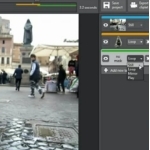
Susan Bradley/Windows Secrets Newsletter
Three little-known apps from Microsoft
Digital photography gives us the freedom to take hundreds of photos and videos of places and people, at very little expense — so many images, that family and friends might be blasé at best about your latest efforts.
But three little-known apps from Microsoft can put some unexpected novelty back into your images.
Microsoft’s department of unusual software
Most of the images we take get little more than an adjustment here and there. But today’s image-editing tools let you do things with photos you never could do with film. Surprisingly, some of the more oddball image/video-editing tools can be found at Microsoft Research, a place where all kinds of curious applications are created and tested. Some of the more successful apps become official Microsoft products. Most of the apps are for exceptionally technical uses, but a few will appeal to average PC users.
Three examples are Photosynth, Image Composite Editor, and Cliplets. The first two let you (with the help of a supporting website) turn multiple photos into a single interactive experience. Your jaded friends might be impressed by the ability to view photographed objects from various angles and to scroll through a scene too wide to fit on the screen.
Cliplets can take a normal video and freeze parts of the image at a single frame while allowing other parts of the image to continue moving. You don’t need a special Microsoft website to share these videos; YouTube will do.
These are specialty programs that do particular jobs. They’re not vital for practicing the art and craft of photography, but they’re fun.
1. Photosynth: Examining a subject from all sides
In real life, we typically examine objects by moving them around — or moving ourselves — to see their fronts, sides, and backs. Try that with a photograph, and all you’ll get is the blank side of a print or the wrong end of a monitor.
Photosynth — a combination of software and website — lets you create a rough analog of that real-world experience. To get an idea of how this works, check out my flower-bouquet study on the Photosynth site, shown in Figure 1. Note how the image rotates to a slightly different perspective when you click an arrow. The results are far from perfect but fun to play with. (The site does a better job of displaying panoramas, as discussed in the following section.)
This excerpt appears with permission from Windows Secrets Newsletter.




